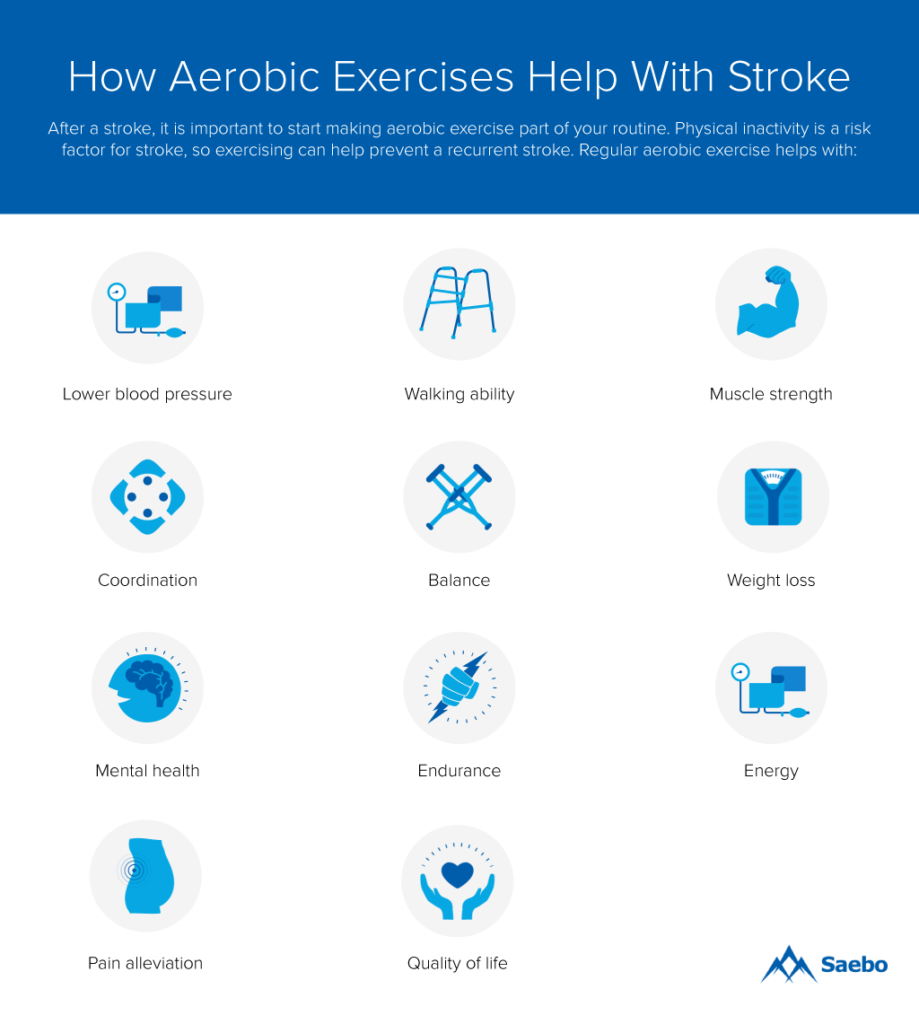Henry Hoffman
Thursday, June 22nd, 2017
Last modified on September 13th, 2022
Caregiver AdviceMotivationstrengtheningStroke AwarenessStroke Rehabilitation Exercises

Everyone knows that exercise is good for their health, and for stroke survivors it is no different. After suffering a stroke, survivors may face numerous barriers to becoming physically active such as disability, fatigue, or depression. While they may have to start slowly and find ways to work around physical barriers, physical exercise is important to both help survivors recover and help them prevent a second stroke.
Unfortunately, despite exercise’s many benefits for stroke patients, too few healthcare professionals prescribe exercise as a form of therapy. Many stroke survivors are lacking the support, knowledge, and tools necessary to begin an exercise program. Getting started with an aerobic exercise program is important to boost stroke recovery. Learn why it’s necessary and how to get started below.
Aerobic exercise (also known as “cardio” exercise) uses oxygen to meet energy demands. This type of exercise helps strengthen and condition the heart muscle and the muscles that aid respiration. This means improving the heart’s pumping efficiency, reducing blood pressure, and facilitating air flow in and out of the lungs.
Aerobic exercises include running, swimming, biking, walking, hiking, dancing, kickboxing, aerobics classes, and any other activity where your heart and breathing rate increase at a rate you can sustain throughout the activity. Exercises that cause you to quickly be out of breath (like sprinting) are not aerobic.
After a stroke, it is important to start making aerobic exercise part of your routine. Physical inactivity is a risk factor for stroke, so exercising can help prevent a recurrent stroke.

In addition to physical benefits, aerobic exercise has been found to promote cognitive recovery in stroke survivors. In a recent study, researchers found that physical activity training significantly improved cognitive deficits among stroke survivors. Training programs as short as 12 weeks were also effective at improving cognition, as well as programs that started three months after the initial stroke.
If you struggle with mobility, you may avoid being active or not know how to start a routine. This can lead to a dangerous cycle of avoiding physical activity that will lead to further muscle weakness. You should be screened by your healthcare provider on your ability to participate in aerobic exercise as soon as possible after your stroke. Once you are cleared by a doctor, you should begin making exercise a part of your rehabilitation routine.
During your screening, your doctor will help you set goals, identify any medical conditions you may have that will require specific accommodations, and help you design an exercise program that meets your capabilities and needs. Depending on your needs, you may work with a therapist that will help supervise you and monitor your progress. Eventually, your goal will be to exercise independently.
Even if you are disabled after your stroke, there are ways to modify exercises so that you can still benefit from them. Here is an example of some aerobic exercises that can be done while standing or sitting:
The American Heart Association recommends for overall cardiovascular health that people get at least 30 minutes of moderate-intensity aerobic activity five days per week or 25 minutes of vigorous aerobic activity three days per week. Depending on your abilities, reaching this level may not be possible. Any amount of exercise is better than nothing though, so work with your doctor to set a realistic goal and routine for yourself.
As with any new exercise routine, it is important talk to your doctor or another qualified healthcare professional before you begin. If you have any pain or discomfort, or a worsening of your symptoms, stop the exercises immediately and contact your healthcare provider.
Getting motivated to exercise can be difficult for anyone, and taking the first step is often the hardest part. When you are recovering from a stroke and unable to participate in the activities you enjoyed before, it can be especially tough to get up and start moving. As hard as it may be to start, exercise is an important part of stroke rehabilitation, and once you see the benefits, it will be hard to stop.
All content provided on this blog is for informational purposes only and is not intended to be a substitute for professional medical advice, diagnosis, or treatment. Always seek the advice of your physician or other qualified health provider with any questions you may have regarding a medical condition. If you think you may have a medical emergency, call your doctor or 911 immediately. Reliance on any information provided by the Saebo website is solely at your own risk.